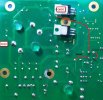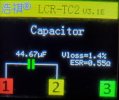I hope R610 is a 5 W type then, and even then it's going to be a toasty boi dissipating 4.03 W. That's 12.9 mA through it.
Let's see where that current is going. Please measure the voltage across all of:
1. R642
2. R640 or R641 and
3. R637/R638/R639
My bets are on the C600 / D607 area being suspect... if things don't change after removing C600, you may have a semi-dead D607 on your hands. It's normally dissipating around 150 mW (17 V * ~8.8 mA), which strikes me as a fair bit for a little SOT-23. It should still be within spec but would be expected to run somewhere around 100°C. Not any more now, of course.
Also, I seem to remember that you didn't see more than ~24 V anywhere in the 255k resistor chain? That's definitely not right. Things should also start out at 335 V there and go down in roughly 100 V steps.
What's puzzling me is that around 70% of the entire current budget (~12.5 mA) is being dissipated in D607. That leaves <4 mA going through the 15 V regulator, or around 50 mW to be dissipated. Well, it only has to be enough to start up the circuit until oscillation kicks in, so it would be enough for that I guess.


